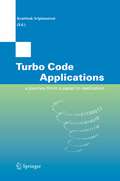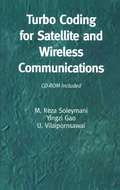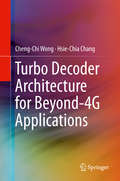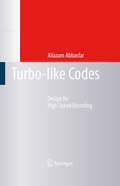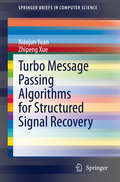- Table View
- List View
Turbo C-Wegweiser Grundkurs
by Ekkehard KaierDas vorliegende Wegweiser-Buch führt den Leser zum erfolgreichen Ein satz von Turbo C und ist in die drei Abschnitte Grundlagen, Turbo C und Programmierkurs mit Turbo C gegliedert. Abschnitt "I Grundlagen": Das Wegweiser-Buch vermittelt aktuelles Grundlagenwissen zur Programmentwicklung allgemein: Was sind Datentypen und Datenstrukturen? Welche Programmstrukturen unterscheidet die Informatik? Wie lassen sich Daten- und Programmstrukturen als Software-Bau steine anordnen? Was versteht man unter der Datei als Datenstruktur? Nach der Lektüre dieses Abschnitts sind Sie in der Lage, die Programm miersprache Turbo C in den Gesamtrahmen der "Datenverarbeitung bzw. Informatik" einzuordnen. Abschnitt "II Turbo C": Das Wegweiser-Buch gibt einen detaillierten Überblick zu Bedienung und Definitionen von Turbo C als Programment wicklungssystem: Wie installiert man das Turbo C-System? Wie erstellt man das erste Programm in Turbo C? Wie bedient man den Editor und den Compiler? Welche Befehle werden zur Softwareentwicklung bereitgestellt? Welche Datentypen, Operatoren und Funktionen stellr das Ent wicklungssystem zur Verfügung? Nach der Lektüre dieses Abschnitts können Sie das Turbo C-System be dienen sowie einfache Programme editieren, speichern, übersetzen und ausführen lassen. Abschnitt "111 Programmierkurs mit Turbo C -Grundkurs": Hier wird ein kompletter Programmierkurs mit den folgenden Problemkreisen angebo ten: Programme zu den einfachen Datentypen. Programme zu -den wichtigen Ablaufstrukturen (Folge-, Auswahl, Wiederholungs- und Unterprogrammstrukturen). Strukturiertes Programmieren (Funktionen, Lokalisierung von Be zeichnern, Parameterübergabe ). Textverarbeitung mit Strings als strukturiertem Datentyp. Tabellenverarbeitung mit Arrays als strukturiertem Datentyp. Dateiverarbeitung sequentiell und im Direktzugriff. VI Vorwort Zahlreiche Aufgaben dienen dem Einüben, Kontrollieren und Anwenden.
Turbo Code Applications: a Journey from a Paper to realization
by Keattisak SripimanwatTurbo Code Applications: a journey from a paper to realization presents c- temporary applications of turbo codes in thirteen technical chapters. Each chapter focuses on a particular communication technology utilizing turbo codes, and they are written by experts who have been working in related th areas from around the world. This book is published to celebrate the 10 year anniversary of turbo codes invention by Claude Berrou Alain Glavieux and Punya Thitimajshima (1993-2003). As known for more than a decade, turbo code is the astonishing error control coding scheme which its perf- mance closes to the Shannon’s limit. It has been honored consequently as one of the seventeen great innovations during the ?rst ?fty years of information theory foundation. With the amazing performance compared to that of other existing codes, turbo codes have been adopted into many communication s- tems and incorporated with various modern industrial standards. Numerous research works have been reported from universities and advance companies worldwide. Evidently, it has successfully revolutionized the digital commu- cations. Turbo code and its successors have been applied in most communications startingfromthegroundorterrestrialsystemsofdatastorage,ADSLmodem, and ?ber optic communications. Subsequently, it moves up to the air channel applications by employing to wireless communication systems, and then ?ies up to the space by using in digital video broadcasting and satellite com- nications. Undoubtedly, with the excellent error correction potential, it has been selected to support data transmission in space exploring system as well.
Turbo Codes: Desirable and Designable
by Alexandre Giulietti Bruno Bougard Liesbet Van Der PerrePREFACE The increasing demand on high data rate and quality of service in wireless communication has to cope with limited bandwidth and energy resources. More than 50 years ago, Shannon has paved the way to optimal usage of bandwidth and energy resources by bounding the spectral efficiency vs. signal to noise ratio trade-off. However, as any information theorist, Shannon told us what is the best we can do but not how to do it [1]. In this view, turbo codes are like a dream come true: they allow approaching the theoretical Shannon capacity limit very closely. However, for the designer who wants to implement these codes, at first sight they appear to be a nightmare. We came a huge step closer in striving the theoretical limit, but see the historical axiom repeated on a different scale: we know we can achieve excellent performance with turbo codes, but not how to realize this in real devices.
Turbo Codes: Principles and Applications (The Springer International Series in Engineering and Computer Science #559)
by Branka Vucetic Jinhong YuanThis book grew out of our research, industry consulting and con tinuing education courses. Turbo coding initially seemed to belong to a restricted research area, while now has become a part of the mainstream telecommu nication theory and practice. The turbo decoding principles have found widespread applications not only in error control, but in de tection, interference suppression and equalization. Intended for use by advanced students and professional engi neers, involved in coding and telecommunication research, the book includes both basic and advanced material. The chapters are se quenced so that the knowledge is acquired in a logical and progres sive way. The algorithm descriptions and analysis are supported by examples throughout the book. Performance evaluations of the presented algorithms are carried out both analytically and by sim ulations. Basic material included in the book has been taught to students and practicing professionals over the last four years in the form of senior undergraduate or graduate courses, lecture series and short continuing education courses.
Turbo Coding (The Springer International Series in Engineering and Computer Science #476)
by Chris Heegard Stephen B. WickerWhen the 50th anniversary of the birth of Information Theory was celebrated at the 1998 IEEE International Symposium on Informa tion Theory in Boston, there was a great deal of reflection on the the year 1993 as a critical year. As the years pass and more perspec tive is gained, it is a fairly safe bet that we will view 1993 as the year when the "early years" of error control coding came to an end. This was the year in which Berrou, Glavieux and Thitimajshima pre sented "Near Shannon Limit Error-Correcting Coding and Decoding: Turbo Codes" at the International Conference on Communications in Geneva. In their presentation, Berrou et al. claimed that a combi nation of parallel concatenation and iterative decoding can provide reliable communications at a signal to noise ratio that is within a few tenths of a dB of the Shannon limit. Nearly fifty years of striving to achieve the promise of Shannon's noisy channel coding theorem had come to an end. The implications of this result were immediately apparent to all -coding gains on the order of 10 dB could be used to dramatically extend the range of communication receivers, increase data rates and services, or substantially reduce transmitter power levels. The 1993 ICC paper set in motion several research efforts that have permanently changed the way we look at error control coding.
Turbo Coding for Satellite and Wireless Communications (The Springer International Series in Engineering and Computer Science #702)
by M. Reza Soleymani Yingzi Gao U. Vilaipornsawai6. 5 137 7 Performance of BTCs and 139 their Applications 7. 1 Introduction 139 7. 2 Some Results from the Literatures 139 7. 3 Applications of Block Turbo Codes. 142 7. 3. 1 Broadband Wireless Access Standard 144 7. 3. 2 Advanced Hardware Architectures (AHA) 145 7. 3. 3 COMTECH EF DATA 147 7. 3. 4 Turbo Concept 149 7. 3. 5 Paradise Data Com 150 Summary 7. 4 151 8 Implementation Issues 153 8. 1 Fixed-point Implementation of Turbo Decoder 153 8. 1. 1 Input Data Quantization for DVB-RCS Turbo Codes 155 8. 1. 2 Input Data Quantization for BTC 157 8. 2 The Effect of Correction Term in Max-Log-MAP Algorithm 159 8. 3 Effect of Channel Impairment on Turbo Codes 163 8. 3. 1 System Model for the Investigation of Channel Impairments 163 8. 3. 2 Channel SNR Mismatch 164 8. 3. 2. 1 Simulation Results 165 8. 3. 3 Carrier Phase Recovery 170 8. 3. 3. 1 The Effect of Phase Offset on the Performance of RM Turbo Codes 170 8. 3. 3. 2 The Effect of Preamble Size on the Performance of RM Turbo Codes 170 8. 3. 3. 3 Simulation Results 170 8. 4 Hardware Implementation of Turbo Codes 171 8. 5 Summary 175 9 177 Low Density Parity Check Codes 9. 1 Gallager Codes: Regular Binary LDPC Codes 177 9. 2 Random Block Codes 178 9. 2. 1 Generator Matrix 179 9. 2.
Turbo Decoder Architecture for Beyond-4G Applications
by Cheng-Chi Wong Hsie-Chia ChangThis book describes the most recent techniques for turbo decoder implementation, especially for 4G and beyond 4G applications. The authors reveal techniques for the design of high-throughput decoders for future telecommunication systems, enabling designers to reduce hardware cost and shorten processing time. Coverage includes an explanation of VLSI implementation of the turbo decoder, from basic functional units to advanced parallel architecture. The authors discuss both hardware architecture techniques and experimental results, showing the variations in area/throughput/performance with respect to several techniques. This book also illustrates turbo decoders for 3GPP-LTE/LTE-A and IEEE 802.16e/m standards, which provide a low-complexity but high-flexibility circuit structure to support these standards in multiple parallel modes. Moreover, some solutions that can overcome the limitation upon the speedup of parallel architecture by modification to turbo codec are presented here. Compared to the traditional designs, these methods can lead to at most 33% gain in throughput with similar performance and similar cost.
Turbo-like Codes: Design for High Speed Decoding
by Aliazam AbbasfarThis book introduces turbo error correcting concept in a simple language, including a general theory and the algorithms for decoding turbo-like code. It presents a unified framework for the design and analysis of turbo codes and LDPC codes and their decoding algorithms. A major focus is on high speed turbo decoding, which targets applications with data rates of several hundred million bits per second (Mbps).
Turbo Message Passing Algorithms for Structured Signal Recovery (SpringerBriefs in Computer Science)
by Xiaojun Yuan Zhipeng XueThis book takes a comprehensive study on turbo message passing algorithms for structured signal recovery, where the considered structured signals include 1) a sparse vector/matrix (which corresponds to the compressed sensing (CS) problem), 2) a low-rank matrix (which corresponds to the affine rank minimization (ARM) problem), 3) a mixture of a sparse matrix and a low-rank matrix (which corresponds to the robust principal component analysis (RPCA) problem). The book is divided into three parts. First, the authors introduce a turbo message passing algorithm termed denoising-based Turbo-CS (D-Turbo-CS). Second, the authors introduce a turbo message passing (TMP) algorithm for solving the ARM problem. Third, the authors introduce a TMP algorithm for solving the RPCA problem which aims to recover a low-rank matrix and a sparse matrix from their compressed mixture. With this book, we wish to spur new researches on applying message passing to various inference problems. Provides an in depth look into turbo message passing algorithms for structured signal recoveryIncludes efficient iterative algorithmic solutions for inference, optimization, and satisfaction problems through message passingShows applications in areas such as wireless communications and computer vision
Turbo Pascal 4.0 von A. Z: Eine alphabetisches Nachschlagewerk zur Programmiersprache mit Beispielen und Querverweisen
by Anton LiebetrauTurbo Pascal 5.0/5.5 Units und Utilities: Die optimale Toolbox für den Profi mit 180 Routinen
by Anton LiebetrauTurbo Pascal 5.0 für Naturwissenschaftler und Ingenieure (Programmieren von Mikrocomputern #39)
by Ekbert HeringTurbo-Pascal für Ingenieure: Eine Einführung mit Anwendungen aus Naturwissenschaft und Technik
by Hering EkbertTurbo Pascal für Ingenieure
by Ekbert Heringdie Unterschiede zwischen den Versionen vergleichend gegenübergestellt und das Vor gehen geschildert, wie Programme in andere, höhere Versionen umgewandelt werden können. Alle Programme sind für die Version 3 (Zusatz .3TP) und ftir die Version 5.5 (Zusatz .P AS) auf einer Diskette zusammengestellt und sofort lauffahig. Das Buch ist in folgende Abschnitte gegliedert: Im ersten Kapitel erfolgt eine Einführung in Daten- und Programmstrukturen sowie grundsätzliche Anmerkungen zur systematischen Programmentwicklung. Am Schluß des Kapitels wird gezeigt, wie man Turbo Pascal (Version 5) installiert, wie die integrierte Entwicklungsumgebung aufgebaut ist, wie sie benutzt werden kann und ferner das syste matische Vorgehen beim Programmieren in Turbo Pascal. Vor allem ftir die naturwissen schaftlich orientierten Leser wurde gezeigt, welche Ähnlichkeiten die Organisation einer industriellen Fertigung und das Erstellen eines Programmes in Turbo Pascal aufweisen. Am Schluß des ersten Kapitels erfolgt eine Einftihrung in die objektorientierte Program mierung. Das zweite Kapitel erläutert, ausgehend von den logischen Ablaufstrukturen Folge, Aus wahl und Wiederholung, die entsprechenden Befehlsstrukturen in einem Syntaxdiagramm und verdeutlicht sie anhand eines Beispiels durch ein Struktogramm und das zugehörige Programm. Ein wichtiges Element der effizienten modularen Programmierung ist die Unterprogramm technik. An Beispielen wird im dritten Kapitel ihr Einsatz mit den beiden Programmele menten PROCEDURE und FUNCTION erläutert. Im vierten Kapitel wird der Umgang mit Datentypen und Datenstrukturen am Beispiel der Erstellung einer sequentiellen und einer Direktzugriff-Datei geschult. Die Vorgänge beim Dateitransfer zwischen externem Speicher und Rechner werden anschaulich erklärt.
Turbo Pascal Tools: Einsatz von Turbo Pascal in der naturwissenschaftlichen Praxis
by Markus WeberIn den gut zwei Jahren seit Erscheinen der ersten Auflage dieses Buches hat sich auf dem Turbo Pascal-Sektor vieles verändert. In erster Linie sind hier die Compiler Versionen Turbo Pascal 4.0 und 5.0 zu nennen. Diese bieten, neben dem geänderten äußeren Erscheinungsbild, gegenüber der Version 3.0 auch eine wesentlich bessere Ka pazitätsausnutzung des Rechners durch einen intelligenteren und schnelleren Compi ler. Zudem können jetzt ganze Segmente in Form von sogenannte Units vorcompiliert abgespeichert und später gelinkt werden. Aus diesen Gründen erschien es mir ange bracht, das gesamte Werk vor der zweiten Auflage gründlich zu überarbeiten. Ich möchte an dieser Stelle vor allem meiner Frau und meiner Tochter dafür danken, daß sie während der Überarbeitungszeit so geduldig auf meine geistige Anwesenheit verzichteten. Außerdem sei an dieser Stelle auch Herrn Dr. Sigfrido Saibene gedankt, der mich in jeder Hinsicht immer tatkräftig und aufopfernd unterstützte. Garching/München, Februar 1989 Marku1 Weber VI Vorwort der ersten Auflage Ich habe das vorliegende Buch in der Absicht geschrieben, dem experimentell tätigen Naturwissenschaftler eine Reihe von Routinen und Programmen an die Hand zu ge ben, die er bei der Aufbereitung von Meßergebnissen auf einem Personal Computer benötigt. In der Kürze war es mir leider nicht möglich, alldie Themen anzusprechen, die ich gerne behandelt hätte. Ich hoffe, die getroffene Auswahl enthält trotzdem viele interessante Themen.
Turbo Pascal Tools: Mathematische Verfahren und Programmroutinen zur Auswertung experimenteller Daten
by Markus WeberTurbo Pascal unter MS-DOS (Programmieren von Mikrocomputern #30)
by Gerd HarbeckDie Programmiersprache Pascal wurde von Prof. Nikolaus Wirth (1974) gezielt für den Einsatz in der Ausbildung entwickelt. Ihre Stärken sind u. a. die problemorientierten Datentypen und viele zweckmäßige, darauf ange paßte Operationen. Die Sprache Pascal unterstützt optimal ein strukturiertes Programmieren und ist leicht zu erlernen, daher hat sie sich weitgehend im Bereich der Ausbildung und auch in der Anwendung durchgesetzt. Seit einigen Jahren ist diese vielseitige und sichere Sprache in ihrem vollen Umfang auch auf Personal Computern (PC) lauffähig. Und seit der Entwick lung des Sprachsystems Turbo Pascal (1983) ist für das Programmieren in Pascal eine optimale Programmierumgebung verfügbar. Eine hilfreiche Programmierumgebung ist vor allem für den Anfänger bedeut sam: Man erlernt eine Programmiersprache umso leichter, je besser man dabei vom Sprachsystem unterstützt wird. Das Sprachsystem Turbo Pascal zeichnet sich durch eine besondere Benutzerfreundlichkeit aus und weist viele weitere Vorzüge auf. Die einfache Kommandostruktur, der erstaunlich schnelle Compiler und der hervorragende Editor, der beim Compilieren auto matisch zur Fehlerbeseitigung herangezogen wird, machen den Zugang zum Programmieren in Pascal so einfach, wie man es vorher nur von BASIC Systernen gewohnt war. Nicht nur der Einsteiger wird durch das Sprachsystem gut unterstützt. Auch der Programmierer, der anspruchsvolle und umfangreiche Programme struk turiert schreiben will, weiß die Vorzüge des Compilers von Turbo Pascal zu schätzen. Beim Schreiben komplexer Programme kommen die Stärken der Sprache Pascal und die Unterstützung durch das System Turbo Pascal voll zur Geltung.


